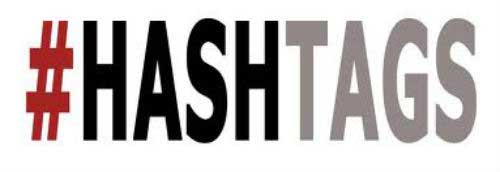![]() Posted by Cameron Francis
on
22 May , 2014
in
News Uncategorized
Posted by Cameron Francis
on
22 May , 2014
in
News Uncategorized

The use of hashtags is becoming more prevalent on social media sites. Hashtags give content marketers the ability to identify conversations that are related to their area of interest and present relative content to their target audience. Approximately one-fourth of tweets use hashtags, however those that use them are engaged twice as often as those that don’t. When used judiciously, hashtags are a potent tool that can increase reach, build community, improve brand recognition, create a social buzz, and have a positive effect upon customer loyalty.

A hashtag is a content label. Hashtags are used to keep track of topics on social media sites. A hashtag can be added to any post or message and they help other users to identify content on the same topic. Simply precede a word or phrase by a hash sign. For instance #web design or #SEO. Users are able to click on a hashtag and they will then be redirected to a page which will display all of the content that has been shared using that hashtag. Hashtags give people the ability to focus on relevant content within a sea of social media messages.
If you’re a Twitter user, you are certainly accustomed to seeing hashtags, since they are frequently used on Twitter. Hashtags can assist you in keeping your tweets organised and to deliver brand messages that are targeted. Trending hashtags can be viewed on your Twitter page. Hashtags.org also lists trending hashtags.
Becoming part of a hashtag conversation is fairly easy, simply click on a hashtag within a tweet. Hashtags can be tracked to determine which hashtags are used most often by your audience.
The use of hashtags is helpful in getting your posts on Google+ noticed in Google search results. When someone clicks on a Google+ hashtag, Google search results will display the original hashtag along with posts that have similar keywords and hashtags. Users then have the ability to chronologically arrange posts that have hashtags and view the “Best of” these posts in the top portion of their stream. Google+ will sometimes add a hashtag to a post automatically if they believe it is relevant.
Facebook began supporting hashtags in 6/2013, but they aren’t used on Facebook nearly as much as on Twitter. Each Facebook hashtag has its own URL. When you click on a hashtag you will be redirected to its associated feed. You may also click on a hashtag that has an origin outside of Facebook. Hashtags can be searched using Facebook’s search bar or your can just type facebook.com/hashtag/hashtag-of-interest in a browser. Posts can also be created directly within a hashtag feed or hashtag search results.
You can increase your reach and build a network of brand followers who are influential using hashtags. If hashtags aren’t used on Instagram, your images aren’t public, which makes it difficult to be discovered by a target audience. For instance, #FlashbackFriday provides encouragement for users to post old photos. To maximise shares, use a minimum of one hashtag in each of your images.
Pinterest uses hashtags in a similar manner as the aforementioned platforms. A tag is applied to a post that indicates its topic so that other users can locate this content in searches that are related. A hashtag within your post will be bolded, and it is turned into a search link that directs Pinterest users to pinterest.com/search/?q=hash-tag-of-interest. When users click on the same hashtag in another user’s profile, your tagged content will also be displayed.
It’s a good idea to use one or more hashtags in each of your posts. If you put more than that, your messages will be perceived as spam by your followers.